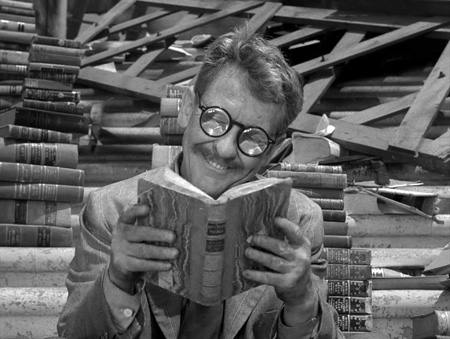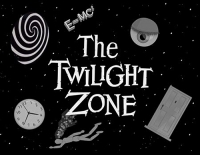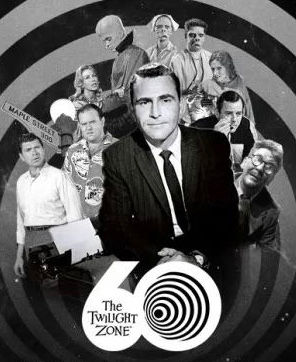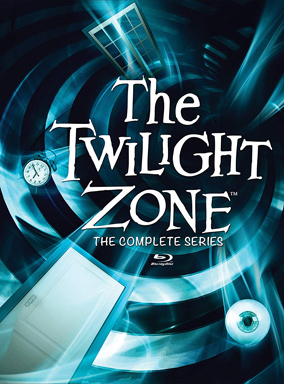Coate: Which are the series’ standout episodes?
Parisi: There is a group of episodes that are consistently ranked as “classics” by the fans, and I think that most of them deserve that distinction. Eye of the Beholder, To Serve Man, Time Enough at Last, and Nightmare at 20,000 Feet are among the most popular and the best.
Pilato: As far as I’m concerned every episode of The Twilight Zone is a stand-out episode. But having to choose some of my personal favorites, I would have to go with those episodes that center around the “zone” as an actual physical strange “place” or again, a particular “realm” in which people suddenly find themselves; as opposed to a “situation.” Some prime examples of this are Walking Distance (10-30-59), A Stop at Willoughby (5-6-60), and Little Girl Lost (3-16-62).
In Distance, a man, played by Gig Young, seemingly travels back to a simpler time where he meets his younger self. In Willoughby, another man, this time portrayed by Jack Daly, also finds himself, seemingly, traveling back to a simpler time. In Lost, a young married couple (Robert Sampson and Sarah Marshall) “lose” their daughter (Tracy Stratford, and the voice of Rhoda Williams) to a realm…and there’s that word again…that exists “somewhere”…in some kind of “other dimension” that co-exists in their home.
The characters in each of these episodes are confronted with a journey to some intangible, yet tangible location, as opposed to an episode like Time Enough at Last (11-20-59), in which a librarian (Burgess Meredith) who loves to read in a very real world is the lone survivor of a very real earthquake in that world. The twist here is that the librarian breaks his glasses, and is consequently incapable of reading any of the countless books to which he now has access, albeit amidst the rubble of concrete and destruction resulting from the earthquake. There is a tragic irony in a potentially very real situation, whereas the characters of Distance, Willoughby and Lost, find themselves dealing with or being confronted by very “unreal” realities, however pleasant or unpleasant those may be. (And please do feel free to make any reference or correlation here to the 1998 Twilight Zone-esque feature film Pleasantville.)
Another great example of characters existing in a surreal place is A World of Difference (3-11-60), in which a man (portrayed by Howard Duff) isn’t sure if he’s an actor or the character he’s playing in a movie. Now somewhere in between all of those episodes, there are segments like People Are Alike All Over (3-25-60), in which a very real astronaut (Roddy McDowell) finds himself on a very real excursion to Mars, where he is ultimately placed “on display” in his own “habitat”…an environment of his Earth-like home. By the episode’s end, we learn he was placed in a zoo-like-cage, where he is observed by Martians, who resemble human appearance, if only via illusion and their mind control of the astronaut.
Besides this story being a standout “middle-ground” episode of The Twilight Zone that combines the best of all elements of the show, People still doesn’t categorize itself as the ultimate Zone episode for me because it is essentially based in reality, or at least potential reality. And forget that sometime later the original Star Trek pilot episode The Cage (which was subsequently reworked as a two-part Trek episode called The Menagerie) seems to have lifted so much from People, with regard to premise and story. While, also, too, Cage/Menagerie, and Lost all feature Susan Oliver as a guest star. So, I guess that’s being in The Twilight Zone on a whole other level.
In either case, I prefer the “surreal” episodes of The Twilight Zone, as opposed to the more reality-based episodes. And even though I enjoy each and every one of the Zone segments, I find myself liking less the “ambiguous-ending” episodes in which the audience is left to decide for themselves if the characters are truly experiencing what we are seeing, or if it is “all in their mind.” For example, Where Is Everybody? (10-2-59), in which we are left to wonder if a man (Earl Holliman) is either really lost or if he’s lost his mind.
Rubin: Artistically, Eye of the Beholder, The Howling Man and The Invaders stand out as amazingly creative episodes. I also believe that Rod Serling’s poignant and nostalgic side is plainly visible in the enormously entertaining Walking Distance and A Stop at Willoughby. I’m also partial to three episodes involving air travel — Nightmare at 20,000 Feet, The Odyssey of Flight 33 and The Last Flight. I would also give five out of five stars to Nick of Time, Time Enough at Last, The Monsters Are Due on Maple Street, To Serve Man and The Lonely.
Zicree: Night of the Meek, It’s a Good Life, Kick the Can, Walking Distance, On Thursday We Leave for Home, Time Enough at Last, Eye of the Beholder and Nightmare at 20,000 Feet. Of course, there are many more.
Coate: Which episode is your favorite?
Parisi: My favorite episode is Walking Distance, Rod Serling’s sentimental journey back in time to the carefree days of his boyhood in Binghamton, New York. It’s among Serling’s most autobiographical and I am still affected by it even after having seen it at least 50 times.
Pilato: It’s a tie between Walking Distance and A Stop at Willoughby. Even though Rod Serling had eventually admitted that he wasn’t that crazy about Distance (because some of the logistics within the illogistics of the story didn’t suit him), I love that episode…and Willoughby. Both episodes so fully represent to me what The Twilight Zone is all about…while they also represent I think what everyone ideally wishes they could go back to a simpler time. There is a tremendous amount of nostalgia associated with both of those episodes. For Serling himself, those episodes were special to him, as both ultimately sprang from his longing to return to his own simpler time…and place…his childhood home of Binghamton, New York. From what I understand, both Distance and Willoughby, among other episodes, were inspired by Serling’s solemn walks on the empty streets of the MGM studio back lot when it wasn’t in use. A real-life Twilight Zone, I guess you could say.
Rubin: Burgess Meredith’s four episodes were all wonderful, but I would say my favorite episode of the series would be Time Enough at Last.
Zicree: Walking Distance. It was Serling’s favorite, and his most autobiographical.

Coate: If you were to introduce the show to someone, which would be the best gateway episode(s)?
Parisi: Eye of the Beholder has absolutely every element that makes a great Twilight Zone episode: An unforgettable twist ending; ingenious, disorienting cinematography; emotionally effective dialogue; a sharp morality lesson; and some great “monsters” to boot! There is no other episode that I would consider to be such a perfect introduction to the series.
Pilato: Walking Distance, A Stop at Willoughby and Little Girl Lost.
Rubin: I would start with the very first episode, Where is Everybody? which beautifully launched the series. Followed by Walking Distance, A Stop at Willoughby, The Lonely, Eye of the Beholder, It’s a Good Life and Nightmare at 20,000 Feet.
Zicree: Any of the ones [I previously mentioned].
Coate: Where do you think The Twilight Zone ranks among classic TV shows?
Parisi: Among the “classic” shows, I think The Twilight Zone belongs at the top of the list. At the time that it was produced, [chairman of the Federal Communications Commission] Newton Minnow gave a famous speech in which he described television as a “vast wasteland.” One of the few series that Minnow mentioned as an exception to that description was The Twilight Zone. It was recognized, at least by some, as something special at the time, and it has been repeatedly recognized as such since. About six months ago, a British magazine published an issue devoted to the “100 Greatest TV Shows of All Time.” The only black-and-white television show that was featured on the cover was The Twilight Zone. It stands out from every other TV series of that era.
Pilato: For me, it’s like this: Bewitched, Star Trek, The Twilight Zone, The Dick Van Dyke Show, The Mary Tyler Moore Show, The Six Million Dollar Man and The Bionic Woman, Kung Fu, Life Goes On, Frasier. Those are essentially my Top Ten Favorites, and the Zone is “Number 3.” So, that’s pretty good.
Rubin: Right at the top with The Sopranos, Game of Thrones, Seinfeld and I Love Lucy.
Zicree: It’s my personal favorite of all the shows ever made. It’s influenced every science fiction show that has come since.
Coate: Do you believe The Twilight Zone has been well represented on home video?
Parisi: The most recent Blu-ray collections of The Twilight Zone are superb, and the series has been generally well represented on DVD and even VHS. The special features included in these collections have been excellent.
Pilato: Oh, my gosh, absolutely. The latest Blu-ray release is just phenomenal. The visual transfers are clear as a bell, and there is a dazzling array of “behind-the-scenes” extras.
Rubin: Absolutely. The Blu-ray editions have been amazingly sharp. Sadly, the six video-taped episodes look terrible simply because of the medium in which they were shot.
Zicree: On the Blu-ray set, [yes,] which I produced and provided 52 commentaries on.
Coate: How do you think the 1983 movie and various spin-off series compare to the original series?
Parisi: None of the various spin-offs have consistently captured the spirit of the original series. Part of it is the refusal to film in black-and-white and some of it is the refusal to utilize the half-hour format. I would love to see Jordan Peele’s series produce a season that starts with those two parameters — black-and-white and 30 minutes — and see what happens.
Pilato: You know — remakes, re-dos, and reboots, etc.? It’s a tough call. The “reimagining” category is a strange animal. It kind of goes back to what I said before, about the source material. Whether it’s a reboot of The Twilight Zone or Roseanne, if the original source material, or the case of the reboot, if the original mythology of a particular previously-proven concept is not respected, then any new update or re-do will fail or at the very least not properly succeed or live up to its predecessor.
Rubin: There is no comparison. I believe the black-and-white photography of the original show contributed to its power and otherworldly atmosphere. Once you go forward with stories in color, you lose half of your atmosphere. The 1983 movie had some fun moments, particularly in George Miller’s remake of Nightmare at 20,000 Feet and Joe Dante’s wonderfully whimsical remake of It’s a Good Life. Frankly, knowing they were in color, I never watched the reboots. I did watch the first two episodes of the current reboot. The first episode about the stand-up comic was pretty good, the second episode, the remake of Nightmare at 20,000 Feet was just terrible. Needless to say, I canceled my subscription after that.
Zicree: Far weaker than the original.
Coate: What is the legacy of The Twilight Zone?
Parisi: The phrase “The Twilight Zone” has entered our collective awareness. It’s part of our language. Television catch phrases go in and out of vogue every year, but here we are 60 years after The Twilight Zone debuted, and people who have never seen a single episode of the series will still know exactly what you are talking about if you said “I feel like we’re in The Twilight Zone.” That is a miniscule part of The Twilight Zone’s legacy, but it’s still pretty cool.
Pilato: Just watching the show becomes its own legacy.
Rubin: The Twilight Zone was an enormously creative television series anchored by one of the true giants of the medium, Mr. Rod Serling, a master storyteller who was given unprecedented control over his work. In terms of quality, no show, in my humble opinion, touches it in consistent quality. It also has, arguably, the best casts ever featured in a television series, then or now.
Zicree: Huge. You can’t watch it and not be changed. It’s deeply, brilliantly about our lives and world. And it hasn’t dated one bit.
Coate: Thank you — Nicholas, Herbie, Steven, and Marc — for sharing your thoughts about The Twilight Zone on the occasion of its 60th anniversary.
IMAGES
Selected images copyright/courtesy Cayuga Productions, CBS, Image Entertainment, Rod Serling Memorial Foundation.
- Michael Coate
Michael Coate can be reached via e-mail through this link. (You can also follow Michael on social media at these links: Twitter and Facebook)






